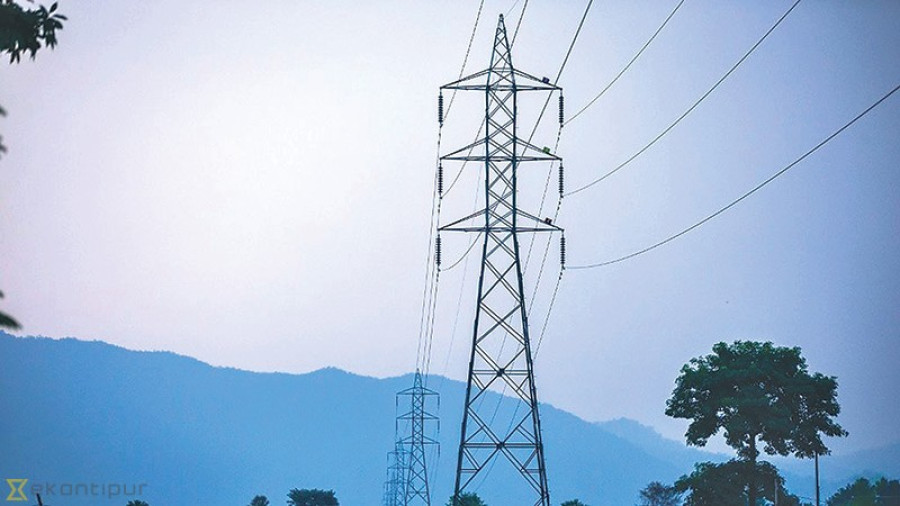Money
Power line project floundering eight years into construction
The Nepal-India Electricity Transmission and Trade Project is stuck at 70pc physical progress.
Prahlad Rijal
Eight years after construction work began on the Hetauda-Dhalkebar-Duhabi transmission line, officials are still struggling to resolve issues pertaining to forest clearance, easement rights and poor work execution by the contractors.
The project, the second component of a multimillion dollar Nepal-India Electricity Transmission and Trade Project, is stuck at 70 percent physical progress, much to the chagrin of World Bank officials. The power line scheme is being built with a $99 million concessional loan from the World Bank and government funding.
“We are yet to receive forest clearance permits in Saptari, Rautahat and Bara; and there are conflicts with locals in five places over easement rights for the installation of around 40 electricity pylons,” said project chief Radhe Sharan Mahat. “The project has also faced setbacks following the dismissal of several contractors for poor performance, and the new contractors are now pointing to technical issues.”
According to Mahat, the project will not meet the completion deadline of April 2020 set by the donor agency unless the issues are resolved immediately.
A total of 131,229 trees need to be chopped down to clear a path for the transmission line in 11 districts in the southern plains, and the project is waiting for cabinet approval to cut down 66,371 trees in Rautahat, Bara and Makwanpur districts.
The Nepal Electricity Authority, the project executing agency, has initiated the process to obtain cabinet approval to cut down 27,201 trees in Rautahat and 11,344 trees in Bara.
Out of the 792 towers that need to be erected for the 288-km transmission line extending from Hetauda to Inaruwa, 319 are located in community forest areas and 473 are located on private land.
“The project has encountered community resistance in Makwanpur district where locals have demanded a realignment of the power line, and a team is studying the possibility of changing the placement,” the project office said. “Moreover, easement right issues remain to be addressed in Sunsari and Siraha districts.”
The transmission and trade project, to which the government has also accorded priority in the next fiscal year’s budget, has five components including a 288-km 400 kV Hetauda-Dhalkebar-Inaruwa transmission line, 220 kV substations in Dhalkebar, Hetauda and Inaruwa and a 140-km 220 kV Hetauda-Bharatpur-Bardaghat transmission line.
During a recent visit to the project site, Nepal Electricity Authority Managing Director Kulman Ghising directed the project office to hire more workers and expedite work, and said that the power utility was committed to resolving forest clearance and easement right issues.
But Ghising’s assurance does not seem to have impressed the chief financier. “The World Bank country director said that the donor would not extend the project beyond April 2020 as it had ‘hit the limitation’ in a recent meeting with Ghising and Province 3 Chief Minister Dormani Poudel,” an anonymous source said.
“The 400 kV transmission line requires a larger area of private land as the width of the right-of-way has been set at 46 meters—23 metres on either side. This has also complicated easement issues,” the official said. “And with poor work execution by the previous contractors on all segments of the project, it is unlikely to meet the deadline set by the donor.”
The World Bank has provided $81.52 million dollars to the government in concessional loans in four installments since the project launched in 2011, records show. Initially, the project was expected to conclude in 2018, but delays caused by implementation problems and natural disasters led to the lender extending the project period till 2020.
The government has accorded priority to the project in the next fiscal year’s budget, but poor work execution plagues the construction of substations and the 140-km transmission line.
The electricity utility recently terminated the construction contract for the Hetauda-Bharatpur portion with Indian contractor ICOMM Tele and confiscated its $3.57 million deposit for non-performance. No new bids have been invited after the Indian contractor was sent away.
In June 2017, the state-owned power utility terminated the contract with Chinese contractor Central China Power Grid International Economic & Trade Co for poor performance on the Bharatpur-Bardaghat portion of the 220 kV power line and three 220 kV substations in Hetauda, Dhalkebar and Inaruwa.
Out of the three substations, the Dhalkebar substation is operational, and the electricity authority has been importing 250 MW from India through it.
After ending the contract with Central China Power Grid, the project entered into a new contract with a consortium of Siemens and Telmos Electronics in 2018 who are working to finish the construction of the substations at Hetauda and Inaruwa.
According to the World Bank, the objectives of the Nepal-India Electricity Transmission and Trade Project are to establish cross-border transmission capacity between India and Nepal of about 1,000 MW to facilitate electricity trade between the two countries and to increase the supply of electricity in Nepal by the sustainable import of at least 100 MW.
The transmission lines and sub-stations are being built to synchronise Nepal’s power system with India to facilitate electricity trade.




 18.12°C Kathmandu
18.12°C Kathmandu














